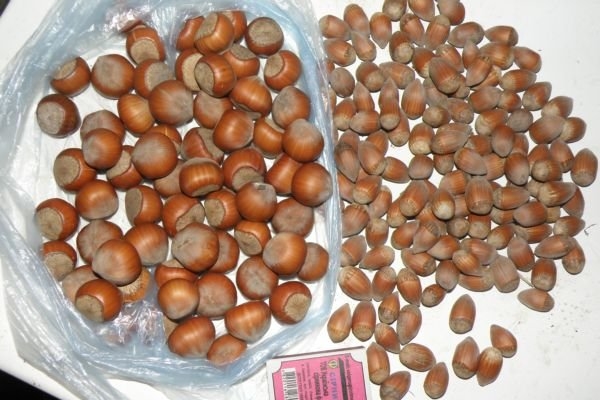Nuts are always appreciated by people. for the benefits they bring to the body. Hazelnuts and hazel (hazelnut) are widely popular.
Often, hazelnuts and hazel are considered the same plant.. But it is not so.
Table of contents
What is different from each other? Biological features
Hazel, like hazelnuts, belongs to the birch shrubs. Bream is considered to be a wild plant.
Filbert is also hazel. Hazelnuts call selected varieties of hazelyielding high yields. More to the hazelnuts include hybrid varieties obtained by crossing with hazelnut Pontus and other species.
The filbert is more thermophilic plant. Hazel fruits are more round in shape. The hazelnut fruits are larger, they are more elongated in shape, they are distinguished by the best commercial quality and higher yield. Not all varieties of hazelnuts are suitable for growing in the middle lane.
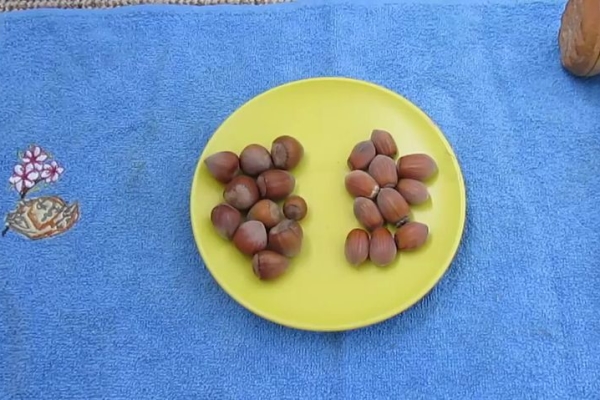
The content of vitamins and nutrients is almost the same in hazel and hazelnuts. Hazel fruits are considered to be more beneficial due to their growth under natural conditions.
Hazelnuts are more nutritious. Hazelnut has a more subtle flavor and less tart taste.
High content of vegetable fat can be considered the main harm nut. Like any nuts, hazelnuts and hazel can cause severe allergic reactions.
In folk medicine, the leaves, bark and wood of the shrub are used.. In official medicine, hazel has not received much use.
Hazel possesses such healing characteristics as:
- strengthening immunity;
- vasodilator;
- lowering cholesterol;
- healing and bactericidal;
- remedy for gastrointestinal disorders;
- increase in volume and saturation of breast milk.
Hazelnut or hazel - which tastes better?
Hazel, or hazelnut
Hazel - wild deciduous shrubsrarely trees. Height of about 3-7 meters. Monoecious cross-pollinated plants.
On one plant are male and female flowers. Blossom in April - May. Flowers are opposite-sex. Fruit ripening begins at the beginning of autumn.
Distinctive features:
- bear fruit annually;
- differ not high yields, which greatly varies from year to year;
- often prone to various diseases and pests;
- hazelnut not demanding growing conditions;
- they bear fruit even in the absence of care.
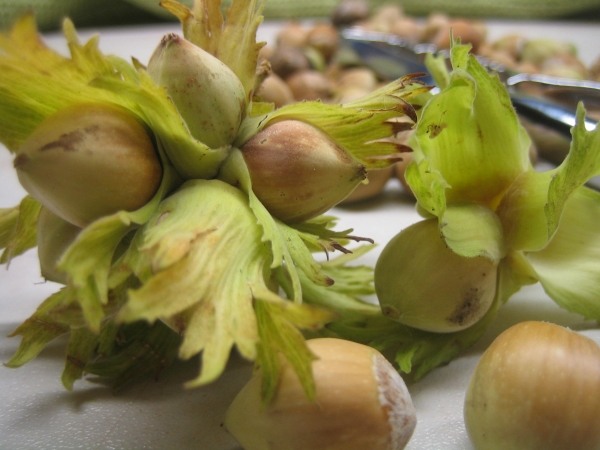
Hazelnut
Hazelnut - cultivated form of hazel.
Distinctive features:
- is more high-yielding;
- distinguished by larger fruits;
- hazelnut yields are more stable;
- resistant to bad weather and pests;
- has a more developed root system;
- pleases with a large selection of varieties, the size of the fruit;
- there is a choice in the size and height of the shrubs;
- more thermophilic plant.
For cultivation in the summer cottage is best to choose varieties resistant to frost. Suitable also for climatic conditions.
Hazelnuts and its features:
How to plant hazel?
It is considered that it is rather difficult to grow hazel on your own plot. This will require considerable time and effort.
Before planting, apply organic fertilizer (compost). Loves watering. Requires pruning (better to leave no more than 15 - 20 stems). Selected shoots for trimming cut as close as possible to the ground.
A place for hazel is better to take along the edge of the site, along a fence or structure.
Hazel blossoms very early, snow can still lie. Very cold and hardy.
Features of the cultivation of hazel:
- lighting: shade-loving;
- the soil: wet, fertile, loose;
- wateringabundant;
- maximum tree height: 10 m.
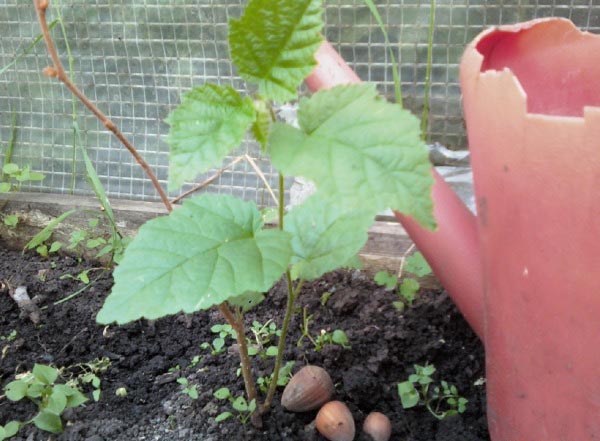
Hazel propagated in several ways:
- The removal of the side shoots is made without separating the escape from the parent plant. A pit is dug about 10–15 cm deep and about 50 cm long. Lay the layers, fill with earth with humus. Liberally pour. Tie the top to the peg.
- Digging in the forest 3-4 shrubs.
- Reproduction by seeds. This planting is best done in the fall. In the grooves with fertilizer lay the seeds at a distance of 15-20 cm
- Growing from walnut.
How to plant hazelnuts?
In the care of hazelnuts rather picky. It is recommended for planting to choose a well-lit places. Does not like thickening. The soil around the shrub is periodically loosened. Loosen shallowly. Do not touch the root system.
Hazelnut prefers fertile soil. Requires a significant landing area. After loosening, water abundantly.
Do not plant one plant. Ideally, 2-3 bushes of different varieties!
It is necessary to plant hazelnuts either in early spring or in autumn (early October). For a good harvest every year to feed.
Features of the cultivation of hazelnuts:
- lighting: light-requiring, but not landing on the south side;
- the soil: wet, fertile, loose;
- watering: plentiful, with obligatory loosening of the soil after each watering;
- maximum tree height: 7 m
How to sow hazelnuts:
Hazelnut can be propagated in various ways:
- Vertical layering.
- Graft.
- Planting seeds.
- The division of the bush.
All properties of hazelnut varieties will remain only during vegetative reproduction. Hazelnuts will grow well both on level ground and on slopes.
Weed, pest and disease control
Unlike hazel, hazelnut prefers the absence of weeds in pristvolnom circle. For an adult plant, mulching can be used.
Early shedding of fruits, their worminess, dry shoots indicate the presence of pests.
These include:
- nut weevil;
- aphid;
- shield;
- acorn moth.
Of the characteristic diseases are:
- powdery mildew;
- brown leaf spot.
When watering, waterlogging and waterlogging should be avoided. This can cause fungal diseases.
In natural conditions, rodents (hares, mice), boars and squirrels are dangerous to hazel.
The reasons for low yields and its increase
Frost will primarily affect productivity. Because of this, the number of ovaries may be small.
Single landings should be avoided. When planting use plants of different varieties for cross-pollination.
Varietal seedlings planted in the fall, are able to bear fruit in the spring. Seedlings obtained from seeds do not possess varietal characteristics. Bring fruit about the second ten years.
To increase the amount of harvest should ensure plant pollination. You can do this manually by spraying it.
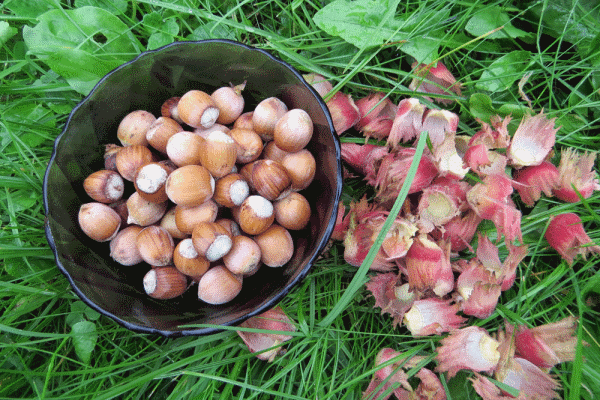
Difference in collection and transportation
Hazel usually ripens a little later. It is better to collect, taking into account the climatic conditions of the place of growth. The main collection is in July – September.. Unripe fruits will be poorly stored.
Well-ripened nuts differ in brown or yellowish skin. It is not customary to pick nuts right off the bushes. They are shaking to the ground. Apply manual collection after dropping completely.
From a material point of view, the collection and transportation of hazelnut is more expensive and disadvantageous. Collection sites may be difficult.
When collecting hazelnuts can be prepared. To clear a place under a bush. The soil is compacted. Lay a cloth or tarpaulin. Then shake off the shrubs.
Harvest dried in a bright, well-ventilated area. Store in fabric bags or boxes.
With proper collection and drying, the nuts are sufficiently transportable, which allows them to be transported over long distances.
There is no big difference between hazelnuts and hazel. Although it is easier to buy a hazelnut sapling for growing in the garden.
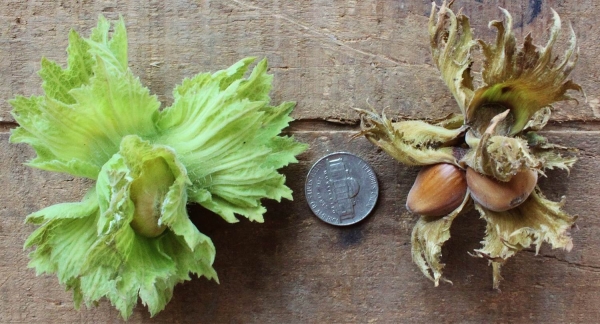
The economic benefits of hazelnuts are higher than hazel. This is due to the high yield of hazelnuts, its resistance to pests, as well as a larger nut. The ease of planting and growing hazelnuts has made it popular for garden plots.
In addition to its usefulness hazelnut and hazelnuts have decorative properties.
